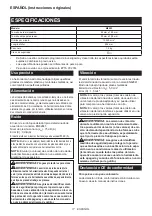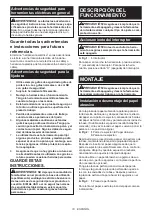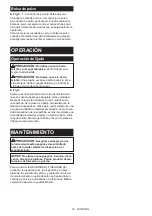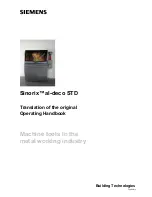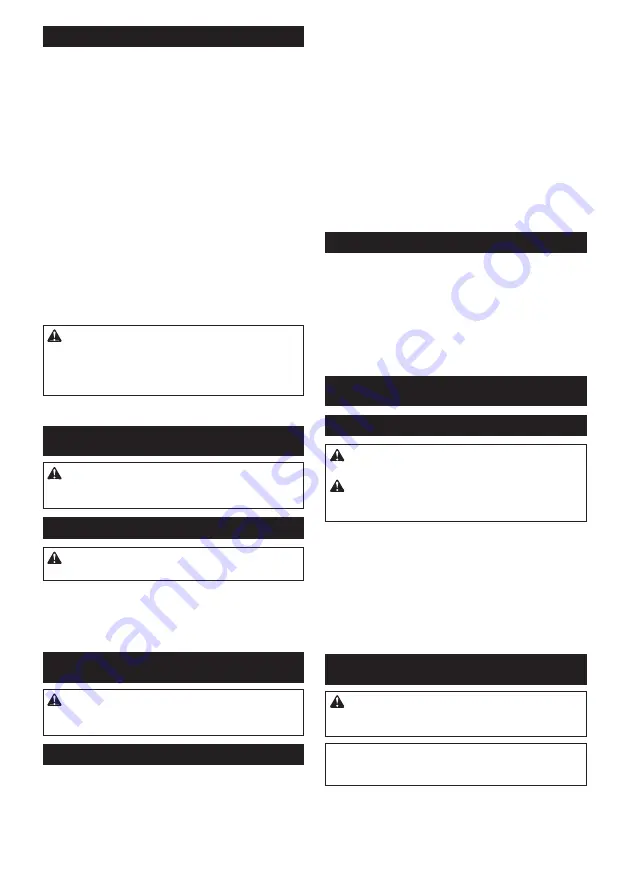
4 ENGLISH
Sander safety warnings
1.
Always use safety glasses or goggles. Ordinary eye
or sun glasses are NOT safety glasses.
2.
Hold the tool firmly.
3.
Do not leave the tool running. Operate the tool
only when hand-held.
4.
This tool has not been waterproofed, so do not
use water on the workpiece surface.
5.
Ventilate your work area adequately when you
perform sanding operations.
6.
Some material contains chemicals which may be
toxic. Take caution to prevent dust inhalation and
skin contact. Follow material supplier safety data.
7.
Use of this tool to sand some products, paints
and wood could expose user to dust contain
-
ing hazardous substances. Use appropriate
respiratory protection.
8.
Be sure that there are no cracks or breakage
on the pad before use. Cracks or breakage
may cause a personal injury.
SAVE THESE INSTRUCTIONS.
WARNING:
DO NOT let comfort or familiarity with
product (gained from repeated use) replace strict adher
-
ence to safety rules for the subject product. MISUSE or
failure to follow the safety rules stated in this instruc
-
tion manual may cause serious personal injury.
FUNCTIONAL DESCRIPTION
CAUTION:
Always be sure that the tool is
switched off and unplugged before adjusting or
checking function on the tool.
Switch action
CAUTION:
Before plugging in the tool, always
be sure that the tool is switched off.
►
Fig.1:
1.
Switch
To start the tool, press the “I (ON)” side of the switch. To
stop the tool, press the “O (OFF)” side of the switch.
ASSEMBLY
CAUTION:
Always be sure that the tool is
switched off and unplugged before carrying out
any work on the tool.
Installing or removing abrasive paper
Open the paper clamp by raising on the lever to release
from the locking port and then Insert the paper end into
the clamping part, aligning the paper edges even and
parallel with the sides of the base. (Bending the paper
beforehand makes attachment easier). Once the paper
is in place, return the lever to its original position.
►
Fig.2:
1.
Clamping part
2.
Abrasive paper
3.
Clamp
lever
Repeat the same process for the other end of the base,
maintaining the proper paper tension.
After inserting the paper, make sure the clamping part
hold it securely. Otherwise the paper will be loose and
subject to slippage, resulting in uneven sanding operation.
When you use an abrasive paper without dust-suction holes,
punch holes with the punch plate (optional accessory).
Place the punch plate over the paper so that the guide
of the punch plate is flush with the sides of the base.
Then press the punch plate to make holes in the paper.
►
Fig.3:
1.
Punch plate
To remove the paper, release the paper clamp as stated
above.
Dust bag
►
Fig.4:
1.
Dust spout
2.
Dust bag
Attach the dust bag onto the dust spout. The dust spout is tapered.
When attaching the dust bag, push it onto the dust spout firmly as
far as it will go to prevent it from coming off during operation.
For the best results, empty the dust bag when it
becomes approximately half full, tapping it lightly to
remove as much dust as possible.
OPERATION
Sanding operation
CAUTION:
Never run the tool without the
abrasive paper.
You may seriously damage the pad.
CAUTION:
Never force the tool.
Excessive
pressure may decrease the sanding efficiency, dam
-
age the abrasive paper and/or shorten tool life.
►
Fig.5
Hold the tool firmly. Turn the tool on and wait until it
attains full speed. Then gently place the tool on the
workpiece surface. A finishing sander is generally used
to remove only a small amount of material at a time.
Since the quality of the surface is more important than
the amount of stock removed, do not bear down on the
tool. Keep the base flush with the workpiece at all times.
MAINTENANCE
CAUTION:
Always be sure that the tool is
switched off and unplugged before attempting to
perform inspection or maintenance.
NOTICE:
Never use gasoline, benzine, thinner,
alcohol or the like. Discoloration, deformation or
cracks may result.
To maintain product SAFETY and RELIABILITY, repairs,
carbon brush inspection and replacement, any other
maintenance or adjustment should be performed by
Makita Authorized or Factory Service Centers, always
using Makita replacement parts.

















